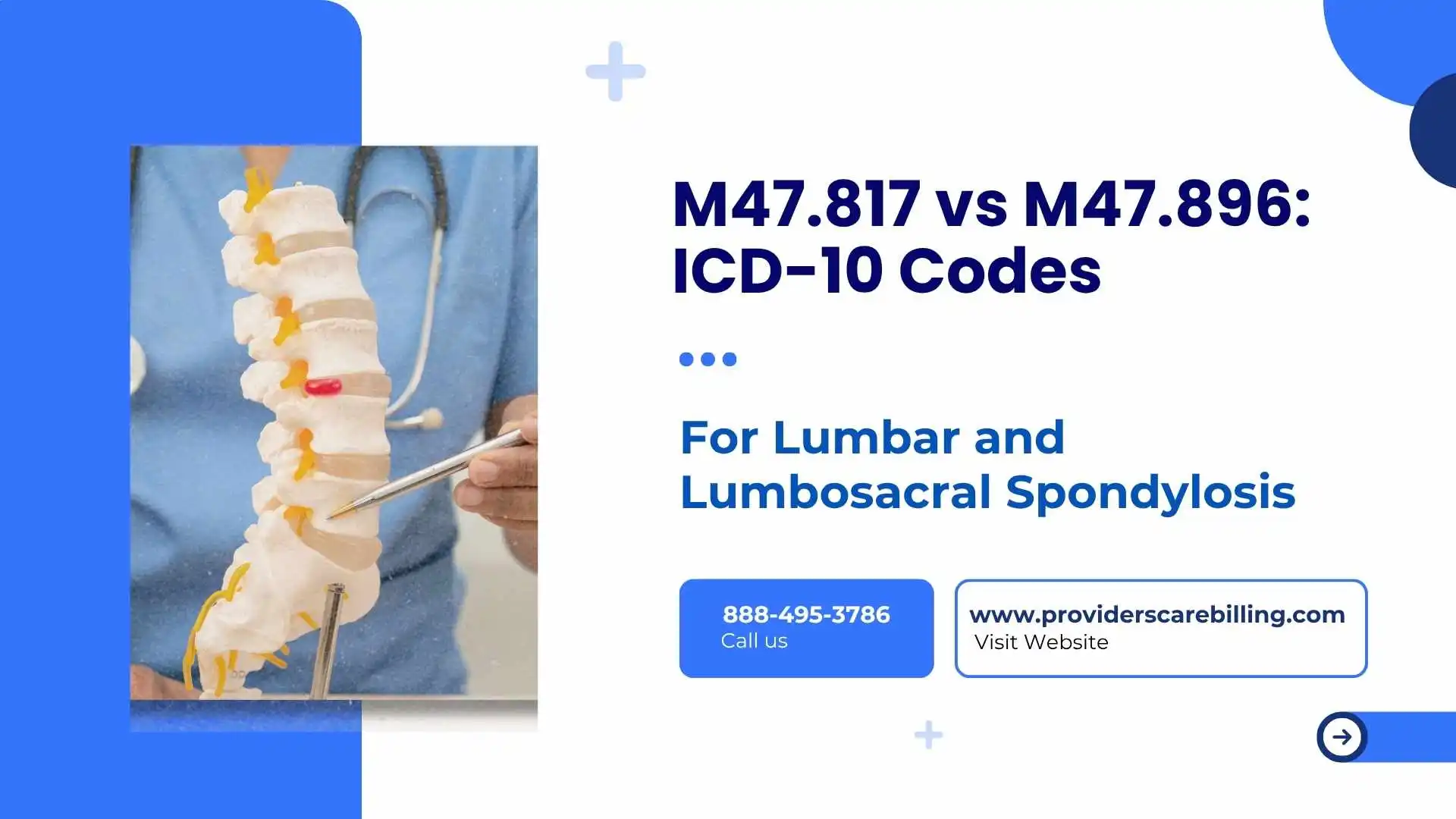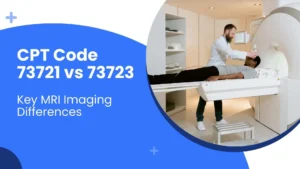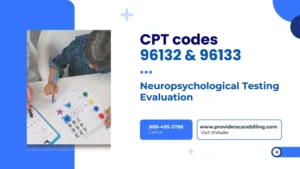Did it ever occur to you that more than 80 percent of adults will at one point in their lives have to experience lower back pain?
Most of those occurrences are pegged on degenerative changes of the spinal area, usually referred to as lumbar or lumbosacral spondylosis. Where ICD-10 coding is concerned, selecting the correct code can make a big difference when it comes to the accuracy of diagnosis and successful reimbursement. In the current article, we discuss M47.817 vs M47.896, the two most specific ICD-10 codes for lumbar and lumbosacral spondylosis. We will explain the differences, symptoms, documentation tips, billing guidelines, as well as why healthcare providers, coders, and billing companies need to be subjected to the right coding.
What is Lumbar and Lumbosacral Spondylosis?
Spondylosis is the term used to describe the degeneration of the backbone, namely the facet joints and the tissues of the intervertebral discs. When the degeneration of the lower back happens, this phenomenon is called lumbar spondylosis, and when the cause of such degeneration spreads to the sacrum, then below this term, lumbosacral spondylosis will be indicated.
Such degenerative changes are associated with:
- Facet arthropathy.
- Spinal osteoarthritis.
- Disc degeneration.
- Spinal stenosis.
- There is spondylolysis or spondylolisthesis.
Symptoms that are common include:
- Problematic back pain.
- Lumbar rigidity.
- Referring to the hips or thighs, radiating pain.
- Limited mobility.
ICD-10 Decode: M47.817 vs M47.896
Spondylosis is a condition of degeneration of the spine that is common in adults at later stages of damage. In the case of coding spinal disorders, it is necessary to distinguish between certain ICD-10 codes, such as M47.817 and M47.896. These sets of codes define various parts of the spine and symptoms. The article provides the proper usage, differences in clinical use, and billing tips of both codes so that accurate claims can be filed.
1.M47.817 radiculopathy, lumbosacral region
M47.817 is applicable to the case of Spondylosis without myelopathy or radiculopathy, lumbosacral region. It is a phenomenon of degenerative changes in the spine of the lumbosacral region without nerve symptoms.
When to use :
- This code is utilized where there is degeneration of the lumbosacral area (L5-S1) and there is no nerve involvement (e.g., no radiculopathy, myelopathy).
- With an interest in location, anatomy, and absence of concomitants.
- Affects mild to moderate disc degenerations and facet joint arthroses in which there is no deviation of symptoms into the neurological field.
2.M47.896 Other spondylosis, lumbar region
The codes M47.896 are linked to Other spondylosis, lumbar region. It is applied when the provider records those conditions of lumbar spondylosis that cannot be categorized into narrower sections.
When to use :
- Applications in the presence of other or unspecified types of lumbar spondylosis, of which type do not fit well in the description.
- It is commonly employed when unusual results come out during the imaging or when recordings have failed to conform to particular types.
- May consist of degeneration, facet arthropathy, or lumbar spinal osteoarthritis.
Key Differences between M47.817 vs M47.896
| Feature | M47.817 | M47.896 |
| Region | Lumbosacral spine (L5-S1) | Lumber spine (L1-L5) |
| Nerve Involvement | No radiculopathy | Not specified |
| Clinical Specificity | More specific anatomically | Less specific |
| Appropriate | Without nerve problems, they are proven by imaging through lumbosacral degeneration | Degeneration of the lumbar under classification |
Case Study
A patient of 58 years is a construction worker with chronic low back pain. Imaging depicts intervertebral facet degenerative changes at L5-S1 in which there is no evidence of nerve compression and disc protrusion. The available diagnosis by the provider is lumbar spondylosis without nerve involvement.
Correct Code :
M47.817- due to the inclusion of spondylosis, following its expounding as one that occurs in the lumbosacral region without complications.
If what was recorded was simply that it was a degenerative lumbar disease with vague findings, then it would be better coded as M47.896.
Best Practices of ICD-10 Coding
Do not fall into the following traps when recording spondylosis of the lumbar spine:
- This math is incorrect (within the acceptable range) as it uses M47.896 even though M47.817 would be more applicable.
- Leaving out radiology reports in claims.
- Excessive code attempts where other coders have no radiculopathy.
- Misidentification of spondylolysis (M43.06) and spondylosis (M47 series).
Documentation Tips
- Be region-specific. Verify whether the lumbar or lumbosacral regions are the source of the issue.
- Observe the involvement of nerves. M47.817 can only be used when there are no nerve symptoms.
- Block the selection of the code using imaging reports.
- Where there are more definite options, prefer not to use unspecified codes.
Spine-related conditions like spondylosis can sometimes be aggravated by chronic allergic inflammation. Learn more about documenting such cases with ICD-10 code J30.9 for allergic rhinitis.
Learn to code instead of guessing the ICD-10.
Contact Providers Care Billing LLC and its out-of-the-box billing plans, EHR system integration, and credentialing programs are sure to enhance the bottom line of your practice.
📞 Call Now: 888-495-3786
📧 Email: Info@providerscarebilling.com
Reimbursement and Policy
With the appropriate ICD-10 code of lumbar spondylosis, it will not only get the right data, but it will have a direct impact on:
- Clean claim filing
- Prior authorization
- Medical necessity defense
- Prevention of audit and take-back
- Productivity and EHR coding alerts
Being a solo practice or small clinic, a medical billing company is a way to get expert assistance that minimizes mistakes and increases revenue.
Conclusion
No matter whether you are evidencing the facet arthropathy, the lumbar osteoarthritis, or the degenerative disc disease, the selection of either M47.817 or M47.896 can either make or break your claim. Since ICD-10 is becoming more detailed, proper coding is the key to the medical necessity, approvals of claims, and reputation of providers. When you have a partner that you can count on, such as Providers Care Billing LLC, then you can avail of expert medical coding assistance, hassle-free regulation of the revenue cycle, and documentation that can pass the audit stage.
FAQS
Q: What is the diagnosis code based on the ICD-10 that lumbar spondylosis carries?
There is unspecified lumbar spondylosis commonly coded as M47.896. To use M47.817 in the lumbosacral region, with no radiculopathy.
Q: What is the distinguishing point between M47.817 and M47.896?
M47.817 is coded when there is no myelopathy/radiculopathy lumbosacral spondylosis.
M47.896 is used when the type of lumbar spondylosis is not specified or other.
Q: But what shall it be when the note mentions lumbar facet arthropathy?
When it is not associated with a nerve, then we use M47.896, or even M47.817, when it is lumbosacral facet disease.
Q: Can lumbar osteoarthritis be listed as spondylosis?
Yes, lumbar osteoarthritis ICD 10 can also be coded in the course of M47.817 or M15.0 based on the details.




